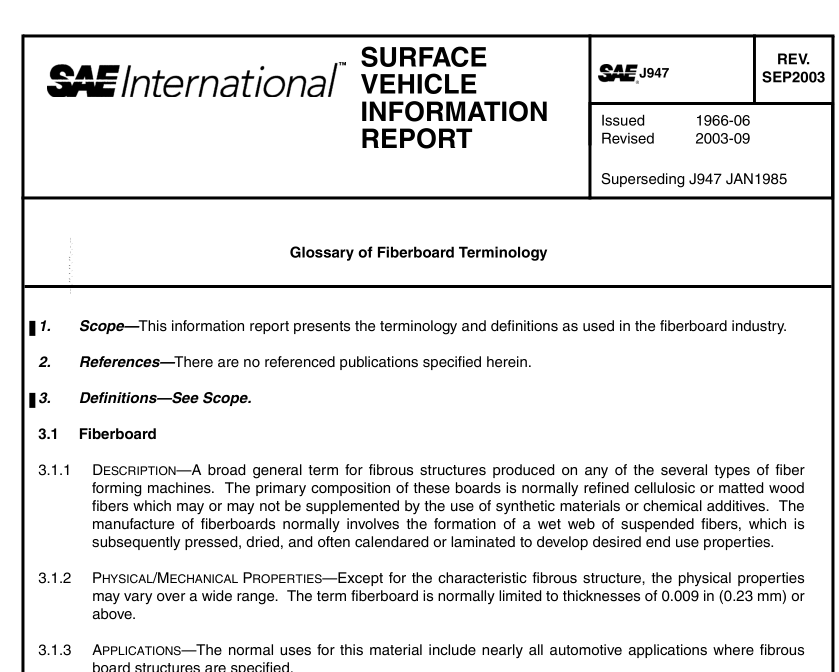SAE J947:2003 pdf download Glossary of Fiberboard Terminology
3.2.2 P APERBOARD
3.2.2.1 Description—A generic term for a sheet manufactured primarily from cellulosic fibers produced by conventional pulping and paper making process and equipment.
3.2.2.2 Physical/Mechanical Properties—Except for the characteristic fibrous structure, the physical properties may vary over a wide range. The paperboards are anisotropic with the board machine direction having greater strength and dimensional stability.
3.2.2.3 Applications—The normal uses for this material include nearly all automotive applications where fibrous board structures are specified.
3.2.3 C HIPBOARD
3.2.3.1 Description—A general term describing a type of fiberboard produced primarily from mixed grades of waste paper and most often produced on a cylinder machine. The final product may be sold as either a single ply or laminated board.
3.2.3.2 Physical/Mechanical Properties—The material is usually characterized by low density and gray color and is used where strength and quality are not required. The final product may be modified by the addition of nonfibrous components to impart water resistance or other special properties. The normal range of thickness is from about 0.009–0.045 in (0.23–1.14 mm) for single ply and 0.050 to over 0.200 in (1 .27– 5.08 mm) for laminated constructions.
3.2.3.3 Applications—Used in applications where appearance and ultimate strength are not important. Typical uses include visor cores, trim panel subfoundations, and some gasket applications. 3.2.4 L AMINATED B OARD
3.2.4.1 Description—A general term describing a board comprised of two or more single plies of board, paper, or other sheet materials in any combination, firmly adhered to each other by means of an adhesive between the plies. The adhesion and cohesion of the entire finished structure are such that it will function as a single unit.
3.2.4.2 Physical/Mechanical Properties—Except for the multiple structure, the physical characteristics of laminated boards vary over a wide range of properties. Because of the general nature of the term, there are few typical physical characteristics.
3.2.4.3 Applications—Typical uses include head liners, trunk liners, glove boxes, and door panels.
3.2.5 W ET M ACHINE B OARD (H OMOGENEOUS )
3.2.5.1 Description—This material is produced on a one cylinder wet machine. It is manufactured by the building up on a roll of a number of wet plies of paper stock (refined cellulose fibers) from a continuous web. The wet plies adhere mechanically to one another in the wet state and, when the desired thickness of board has been reached, the wet stock (approximately 40% solids) is removed from the make roll as a sheet. It is then pressed, dried, and calendared to the desired finished thickness. The pressing and drying operations develop strong fiber-to-fiber chemical and mechanical bonds within the plies and between the ply interfaces.
SAE J947:2003 pdf download
